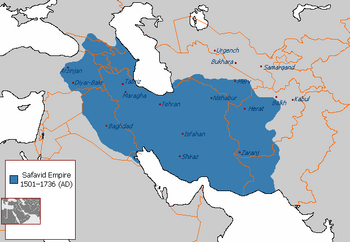Safavid dynasty facts for kids
Quick facts for kids
Safavid dynasty
|
|||||||||||||||||||||||||||||||
|---|---|---|---|---|---|---|---|---|---|---|---|---|---|---|---|---|---|---|---|---|---|---|---|---|---|---|---|---|---|---|---|
| 1501–1736 | |||||||||||||||||||||||||||||||
|
|
|||||||||||||||||||||||||||||||

The Safavid Empire under Shah Abbas the Great
|
|||||||||||||||||||||||||||||||
| Status | Empire | ||||||||||||||||||||||||||||||
| Capital | |||||||||||||||||||||||||||||||
| Common languages |
|
||||||||||||||||||||||||||||||
| Religion | Twelver Shiʻa Islam | ||||||||||||||||||||||||||||||
| Government | Monarchy | ||||||||||||||||||||||||||||||
| Shahanshah | |||||||||||||||||||||||||||||||
|
• 1501–1524
|
Ismail I (first) | ||||||||||||||||||||||||||||||
|
• 1732–1736
|
Abbas III (last) | ||||||||||||||||||||||||||||||
| Grand Vizier | |||||||||||||||||||||||||||||||
|
• 1501–?
|
Mohammad Zakariya Kujuji (first) | ||||||||||||||||||||||||||||||
|
• 1729–1736
|
Nader Qoli Beg (last) | ||||||||||||||||||||||||||||||
| Legislature | Council of State | ||||||||||||||||||||||||||||||
| History | |||||||||||||||||||||||||||||||
|
• Establishment of the Safavid order by Safi-ad-din Ardabili
|
1301 | ||||||||||||||||||||||||||||||
|
• Established
|
1501 | ||||||||||||||||||||||||||||||
|
• Hotaki Invasion
|
1722 | ||||||||||||||||||||||||||||||
|
• Reconquest under Nader Shah
|
1726–1729 | ||||||||||||||||||||||||||||||
|
• Disestablished
|
8 March 1736 | ||||||||||||||||||||||||||||||
|
• Nader Shah crowned
|
1 October 1736 | ||||||||||||||||||||||||||||||
| Currency | Tuman, Abbasi (incl. Abazi), Shahi.
|
||||||||||||||||||||||||||||||
|
|||||||||||||||||||||||||||||||
The Safavid dynasty was one of the most significant ruling dynasties of Iran, often considered the beginning of modern Iranian history. The Safavid shahs ruled over one of the gunpowder empires and one of the greatest Iranian empires after the 7th-century Muslim conquest of Iran. They established the Twelver school of Shia Islam as the official religion of the empire, marking one of the most important turning points in Muslim history.
The Safavid dynasty had its origin in the Safavid order of Sufism, which was established in the city of Ardabil in the Azerbaijan region. It was an Iranian dynasty of Kurdish ancestry but during their rule they intermarried with Turkoman, Georgian, Circassian, and Pontic Greek dignitaries. From their base in Ardabil, the Safavids established control over parts of Greater Iran and reasserted the Iranian identity of the region, thus becoming the first native dynasty since the Sasanian Empire to establish a national state officially known as Iran.
The Safavids ruled from 1501 to 1722 (experiencing a brief restoration from 1729 to 1736) and, at their height, they controlled all of what is now Iran, Azerbaijan Republic, Bahrain, Armenia, eastern Georgia, parts of the North Caucasus, Iraq, Kuwait, and Afghanistan, as well as parts of Turkey, Syria, Pakistan, Turkmenistan and Uzbekistan.
Despite their demise in 1736, the legacy that they left behind was the revival of Iran as an economic stronghold between East and West, the establishment of an efficient state and bureaucracy based upon "checks and balances", their architectural innovations and their patronage for fine arts. The Safavids have also left their mark down to the present era by spreading Twelver Islam in Iran, as well as major parts of the Caucasus, Anatolia, and Mesopotamia.
See also
 In Spanish: Imperio safávida para niños
In Spanish: Imperio safávida para niños



